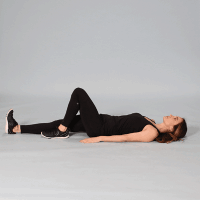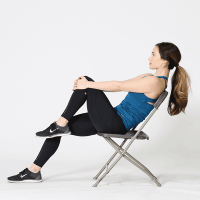Every step sends a sharp reminder through your hip, each movement amplifying an intimate discomfort that seems to originate deep within. If you’ve felt this pain, you might be familiar with the often-overlooked iliopsoas muscle. Nestled deep in the hip, this muscle plays a pivotal role in our daily activities, from walking to bending. But when strained or overworked, the iliopsoas doesn’t shy away from signaling distress.
This guide delves deep into the intricacies of iliopsoas pain, offering both understanding and solutions. Whether you’re a long-distance runner, a desk-bound professional, or someone who’s inadvertently overexerted, we’re here to help you navigate the path from recognizing symptoms to complete recovery.
Contents
Anatomy of the Iliopsoas Muscle
 The iliopsoas muscle isn’t just another muscle; it’s foundational to our body’s framework. To truly understand the pain originating from it, we must first dive into its anatomical context.
The iliopsoas muscle isn’t just another muscle; it’s foundational to our body’s framework. To truly understand the pain originating from it, we must first dive into its anatomical context.
- Location and Composition: Situated deep within the abdomen and pelvis, the iliopsoas is often considered the powerhouse of the hip muscles. It’s primarily composed of two muscles: the iliacus and the psoas.
- Role in Hip Flexion: Every time you lift your knee towards your chest, bend at the waist, or even just walk, you’re calling upon the iliopsoas muscle. It plays a pivotal role in hip flexion, making it a central player in nearly every lower body movement.
- Importance in Posture: Beyond movement, the iliopsoas is critical in maintaining an upright posture. It stabilizes the spine, ensuring that we can stand tall and move without discomfort.
Understanding the complex nature and role of the iliopsoas offers insights into why issues with this muscle can lead to significant discomfort. Its deep location can sometimes make it hard to pinpoint pain, but recognizing its function and influence can be the first step in seeking targeted relief.
Recognizing Iliopsoas Pain
Iliopsoas muscle issues can manifest in nuanced ways, often leading individuals to confuse it with other hip-related discomforts. Understanding the distinct pain patterns and sensations of iliopsoas pain can empower you to seek appropriate intervention.
- Localized Deep Pain: Unlike surface muscle strains, iliopsoas pain is often felt deep within the groin or front of the hip. It’s a pain that seems to emanate from the inner depths of the hip, making it distinct from more superficial discomforts.
- Pain During Movement: Activities that involve hip flexion, such as climbing stairs, lifting the knee, or even transitioning from sitting to standing, can exacerbate iliopsoas pain. You might also feel discomfort when stretching the hip or extending the leg backward.
- Snapping Sensation: Some individuals report a “snapping” or “clicking” feeling in the front of the hip. This is due to the iliopsoas tendon sliding over bony prominences in the hip.
- Pain After Prolonged Sitting: Remaining seated for extended periods, especially with the hip in a flexed position, can cause the iliopsoas to become tight or cramped, leading to increased pain upon standing.
- Referred Pain: While the pain’s epicenter is in the hip or groin, it can sometimes radiate down the front of the thigh or even towards the lower back, making diagnosis trickier.
Being attuned to these specific sensations and patterns can help differentiate iliopsoas discomfort from other types of hip pain. This understanding paves the way for targeted treatments and interventions.
Common Causes of Iliopsoas Discomfort

The iliopsoas muscle, given its central role in hip movement, is prone to strain and injury. While there can be numerous triggers, some common causes stand out:
- Overuse: Engaging in activities that repetitively use the hip flexors, like running, dancing, or certain gym exercises, can overstrain the iliopsoas, leading to discomfort.
- Acute Injury: Direct trauma or sudden movements, especially when the muscle isn’t properly warmed up, can result in strains or even tears in the iliopsoas.
- Hip Capsule Tightness: If the connective tissue surrounding the hip joint becomes tight, it can put undue pressure on the iliopsoas muscle, causing pain.
- Postural Issues: Poor posture, especially anterior pelvic tilt, can place consistent strain on the iliopsoas, making it more susceptible to discomfort.
- Underlying Health Conditions: Arthritic changes in the hip joint or spinal issues like lumbar herniated discs can indirectly affect the iliopsoas muscle and lead to pain.
Understanding the root cause of the discomfort is the first step towards devising an effective recovery plan. If one or more of these factors resonate with your experience, it might be worth seeking professional insight to ensure accurate diagnosis and treatment.
Immediate Self-Care Remedies
 When iliopsoas discomfort strikes, prompt action can help alleviate the pain and prevent it from worsening. Here are some immediate remedies to consider:
When iliopsoas discomfort strikes, prompt action can help alleviate the pain and prevent it from worsening. Here are some immediate remedies to consider:
- Rest: It sounds simple, but taking a break from strenuous activities can give the iliopsoas muscle the much-needed time to heal. Avoid activities that cause or intensify the pain.
- Ice Application: Applying ice packs to the affected area can reduce inflammation and provide pain relief. Remember to wrap the ice pack in a thin cloth or towel to prevent frostbite. Apply for 15-20 minutes every 1-2 hours during the first 48 hours.
- Gentle Stretching: Engaging in mild iliopsoas stretches can help relieve tightness. Lie on your back with both knees bent. Hug one knee to your chest while extending the other leg straight out on the floor. Hold for 20-30 seconds and switch sides.
- Over-the-Counter Pain Relievers: Non-prescription pain relievers, like ibuprofen, can be taken to manage inflammation and pain. However, always consult a healthcare professional before starting any medication.
- Maintain Good Posture: Being mindful of your posture, especially when sitting for extended periods, can reduce unnecessary strain on the iliopsoas muscle.
- Warm Compress: After the first 48 hours or if the muscle feels particularly tight, applying a warm compress can relax the muscle and increase blood flow to the area, aiding in healing.
The key is to listen to your body. If a specific remedy exacerbates the pain or if the discomfort persists, it’s essential to seek medical attention.
Strengthening and Stretching Exercises
The iliopsoas, as a primary hip flexor, plays a pivotal role in our daily activities. To ensure its optimal function and to fend off discomfort, incorporating specific exercises into your routine can be beneficial. Here are some effective stretches and strengthening exercises:
Psoas Activation Exercise

- How to do it:
- Lie on your back with your knees bent and feet flat on the floor.
- Slowly lift one knee towards your chest, keeping the other foot on the ground.
- Push your lower back into the floor. You should feel the front of your hip working.
- Hold for a count of three, then lower the leg. Repeat on the other side.
Standing Hip Flexor Stretch

- How to do it:
- Stand tall and take a step back with your right foot.
- Bend both knees and sink into a lunge position, keeping your upper body straight.
- Push your hips forward. You should feel a stretch in the front of your right hip.
- Hold for 20-30 seconds and switch sides.
Seated Butterfly Stretch

- How to do it:
- Sit on the floor with your knees bent and soles of your feet touching.
- Hold onto your ankles and gently push your knees towards the floor using your elbows.
- Maintain an upright spine and feel the stretch in your inner thighs and hips.
- Hold for 20-30 seconds.
Bridging Exercise%22%20transform%3D%22translate(.5%20.5)%22%20fill-opacity%3D%22.5%22%3E%3Cellipse%20fill%3D%22%23797979%22%20rx%3D%221%22%20ry%3D%221%22%20transform%3D%22rotate(164.5%2050.5%2041.3)%20scale(78.31771%2024.09058)%22%2F%3E%3Cpath%20fill%3D%22%23f3f3f3%22%20d%3D%22M206%20176.4L8.1%20197.2%200%20119.6l197.9-20.8z%22%2F%3E%3Cellipse%20fill%3D%22%23ececec%22%20cx%3D%2220%22%20cy%3D%2218%22%20rx%3D%22102%22%20ry%3D%2256%22%2F%3E%3Cellipse%20fill%3D%22gray%22%20rx%3D%221%22%20ry%3D%221%22%20transform%3D%22matrix(-12.80176%2022.39649%20-25.7233%20-14.70335%20148.7%2055.2)%22%2F%3E%3C%2Fg%3E%3C%2Fsvg%3E)
- How to do it:
- Lie on your back with knees bent and feet flat on the floor.
- Tighten your glutes and lift your hips off the floor, creating a straight line from your knees to shoulders.
- Hold the bridge position for a few seconds, then lower down. This exercise strengthens the glutes, which can help offload the iliopsoas.
Hip Flexion Strengthening

- How to do it:
- Sit on a chair with your back straight.
- Lift one knee towards your chest without leaning backward.
- Hold for a few seconds, then lower. Switch legs.
It’s essential to approach these exercises gently, especially if you’re currently experiencing pain. Over time, as the muscle strengthens and becomes more flexible, you might find the pain diminishing. However, always consult with a physiotherapist or fitness professional to ensure you’re executing the movements correctly and safely.
Recognizing When Expert Intervention is Needed
While self-care and home remedies can provide relief in many instances, it’s crucial to understand when the pain might signal something more serious. Consider seeking professional advice if:
- The pain persists or worsens despite self-care measures.
- Discomfort interferes with daily activities or disrupts sleep.
- You experience sudden, sharp pains or a sensation of “snapping” in the hip.
- The pain is accompanied by swelling, redness, or warmth in the hip area.
- There’s limited range of motion, or you find it difficult to walk or climb stairs.
Consulting with a specialist can provide a comprehensive evaluation, accurate diagnosis, and tailored treatment plan. Such expert guidance can ensure faster recovery, prevent potential complications, and reduce the risk of recurrence.
Alternative Therapies for Enhanced Recovery
Broadening the scope of recovery methods can expedite healing and provide holistic relief. Here are some alternative treatments to consider:
- Physiotherapy: A targeted approach, involving manual therapy, exercises, and advice, aimed at enhancing mobility and reducing pain. Physiotherapists can provide customized exercise regimens to specifically address iliopsoas issues.
- Massage Therapy: A therapeutic massage can help relax the tightened muscles, improve blood circulation, and promote healing in the affected area.
- Acupuncture: By stimulating specific points in the body, acupuncture can help alleviate pain, reduce muscle tension, and promote overall well-being.
- Heat Therapy: Applying warmth can relax and soothe muscle tension, enhancing blood flow to the painful area, aiding in recovery.
Combining conventional treatments with these alternative therapies can offer comprehensive relief, ensuring a smoother, quicker path to recovery. However, always ensure any new therapy is pursued under professional guidance to avoid unintended complications.
Conclusion
Navigating the intricacies of iliopsoas muscle pain can be challenging, but with the right knowledge and approach, recovery is within reach. Remember, it’s essential to listen to your body and seek expert guidance when needed. If you’re experiencing Hip pain, physical therapy for hip pain at PhysioMantra can help: Book an online physical therapy session.




